
Festuca rubra is a species of grass known by the common name red fescue, creeping red fescue or the rush-leaf fescue. It is widespread across much of the Northern Hemisphere and can tolerate many habitats and climates. It is best adapted to well-drained soils in cool, temperate climates; it prefers shadier areas and is often planted for its shade tolerance. Wild animals browse it, but it has not been important for domestic forage due to low productivity and palatability. It is also an ornamental plant for gardens.
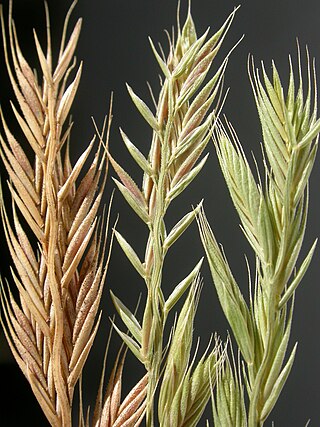
Vulpia is a widespread genus of plants in the grass family, native to many countries around the world and naturalized in many of the nations to which it is not native. It is most common in temperate regions.

Vulpia bromoides, squirreltail fescue, barren fescue or brome fescue, is a species of grass in the family Poaceae. It is a winter annual native to Europe, North Africa, and West Asia, but has been introduced to parts of the America, South Africa, Australia, New Zealand and isolated parts of East Asia.

Festuca idahoensis is a species of grass known by the common names Idaho fescue and blue bunchgrass. It is native to western North America, where it is widespread and common. It can be found in many ecosystems, from shady forests to open plains grasslands.

Hainardia is a genus of coastal plants in the grass family, native to the Mediterranean Basin.

The Tumey Hills are a low mountain range in the interior California Coast Ranges, in western Fresno County, California. The Tumey Hills area is part of the U.S. Bureau of Land Management (BLM), which is a division of the United States Department of the Interior. This BLM land is under Fire Season Vehicle Restrictions from mid-April to mid-October. No motorized access is allowed during this time period.

Chloris virgata is a species of grass known by the common names feather fingergrassfeathery Rhodes-grass and feather windmill grass.

Poa compressa, the Canada bluegrass or flattened meadow-grass, is a perennial flattened meadow grass, similar to common meadow-grass, Poa pratensis. It is native to Europe but it can be found nearly worldwide as an introduced species. It grows in old wall tops, pavement cracks, dry stony grassland, and many types of wild habitat. It has a flattened stem, 23–30 cm tall, a close one sided panicle of grey green, with purple florets.
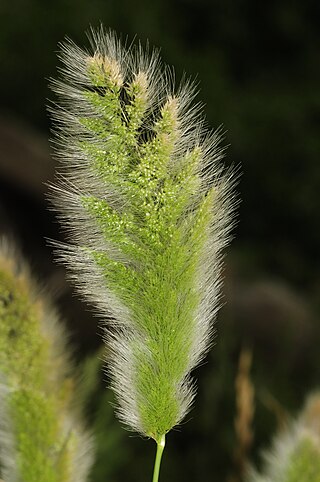
Polypogon monspeliensis, commonly known as annual beard-grass or annual rabbitsfoot grass, is a species of grass. It is native to southern Europe, but it can be found today throughout the world as an introduced species and sometimes a noxious weed. It is an annual grass growing to heights between 5 centimeters and one meter. The soft, fluffy inflorescence is a dense, greenish, plumelike panicle, sometimes divided into lobes. The spikelets have long, thin, whitish awns, which give the inflorescence its texture.

Panicum dichotomiflorum, known by the common names fall panicgrass, autumn millet, and fall panicum is a species of Poaceae "true grass". It is native to much of the eastern United States and parts of Canada, and it can be found in the Western United States through California. It may be an introduced species in some western climates. It grows in many types of habitat, including disturbed areas and chaparral habitats.
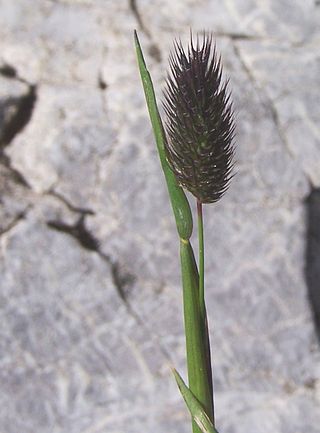
Phleum alpinum is a species of grass known by the common names alpine cat's-tail, alpine timothy and mountain timothy.
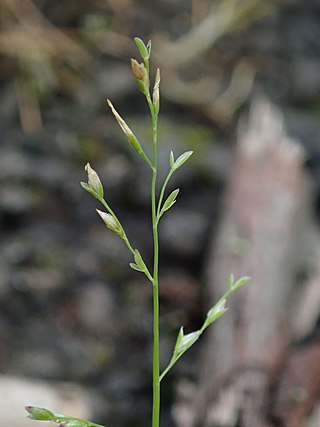
Poa infirma is a species of grass known by the common names early meadow-grass and weak bluegrass. It was first described from a specimen found in Colombia, but it is actually an introduced species in the Americas and is native to Europe. It grows in many types of habitat, including disturbed areas. It is very similar to Poa annua, which is probably a daughter species, and it is often mistaken for P. annua unless it is closely examined.

Schismus barbatus is a species of grass known as common Mediterranean grass and kelch-grass. It is native to Eurasia, and it is also known as an introduced species in the southwestern United States. It grows in many habitats, including disturbed areas. It is an annual grass growing in small clumps. The stems grow up to 27 centimeters long and are lined with threadlike leaves. The short inflorescence bears spikelets under a centimeter long.

Setaria verticillata is a species of grass known by the common names hooked bristlegrass, rough bristle-grass and bristly foxtail. It is native to Europe, but it is known on most continents as an introduced species and often a noxious weed. It is a hardy bunchgrass which grows in many types of urban, cultivated, and disturbed habitat. It is a weed of many types of agricultural crops, growing in vineyards and fields. Herbicide-resistant strains have been noted.

Sisyrinchium californicum is a species of flowering plant in the iris family known by the common names golden blue-eyed grass, yellow-eyed-grass, and golden-eyed-grass. It is native to the west coast of North America from British Columbia to central California, where it grows in moist habitat, often in coastal areas.
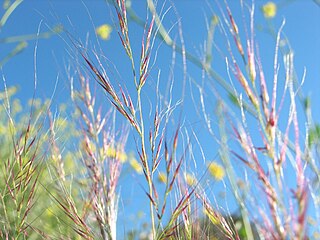
Vulpia microstachys is a species of grass known by the common names small fescue and small sixweeks grass. It is native to western North America from British Columbia to Colorado and New Mexico to Baja California, where it grows in many types of open habitat, including grasslands. It is dominant on some grasslands of California, and it was probably an abundant native grass before the habitat was altered by invasive non-native grasses. It occurs on serpentine soils with associates such as serpentine reedgrass. It is also known from parts of South America. It is an annual grass producing one stem or a clump of several stems growing up to 75 centimeters tall. The inflorescence has several open branches bearing clusters of purple-tinged spikelets. The spikelet has one to six flowers. The grass is usually cleistogamous, its flowers fertilizing themselves.
Sanicula mariversa is a rare species of flowering plant in the family Apiaceae known by the common name Waianae Range black-snakeroot. It is endemic to Hawaii, where it is known only from the Waianae Mountains on the island of Oahu. It is threatened by the degradation of its habitat. It is a federally listed endangered species of the United States.
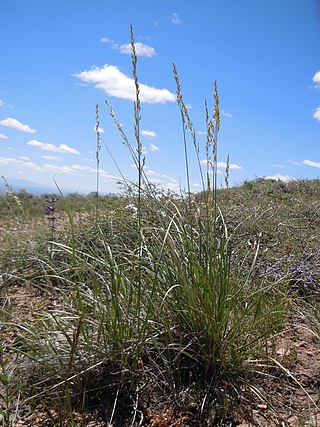
Leucopoa kingii is a species of grass known by the common names spike fescue and King's fescue. It is native to the western United States from Oregon and California east to Nebraska and Kansas.
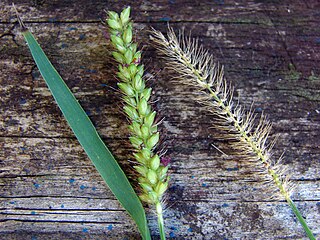
Setaria parviflora is a species of grass known by the common names marsh bristlegrass, knotroot bristle-grass, bristly foxtail and yellow bristlegrass. It is native to North America, including Mexico and the United States from California to the East Coast, Central America and the West Indies, and South America.

Festuca octoflora, also known as Vulpia octoflora, is an annual plant in the grass family (Poaceae). The common name six week fescue is because it supplies about 6 weeks of cattle forage after a rain. Other common names include sixweeks fescue, six-weeks fescue, pullout grass, eight-flower sixweeks grass, or eight-flowered fescue.


















